Epidemiology: Causation in Lung Cancer and Public Health Research
VerifiedAdded on 2023/06/10
|7
|1581
|367
Report
AI Summary
This report explores appropriate research designs for studying the relationship between lung cancer and smoking, emphasizing the importance of causation analysis. It differentiates between cross-sectional, cohort, and case-control studies, highlighting their strengths and weaknesses. The report also identifies suitable study designs for various public health issues, including the association between depression and binge eating, the long-term effects of detention on asylum seekers' health, and the impact of folate supplementation during pregnancy on autism development. It advocates for prospective cohort studies, longitudinal studies, and double-blind placebo-controlled studies based on their specific advantages in addressing each research question. The discussion includes considerations of bias, temporality, and the ability to establish causal links, providing a comprehensive overview of epidemiological research methodologies.
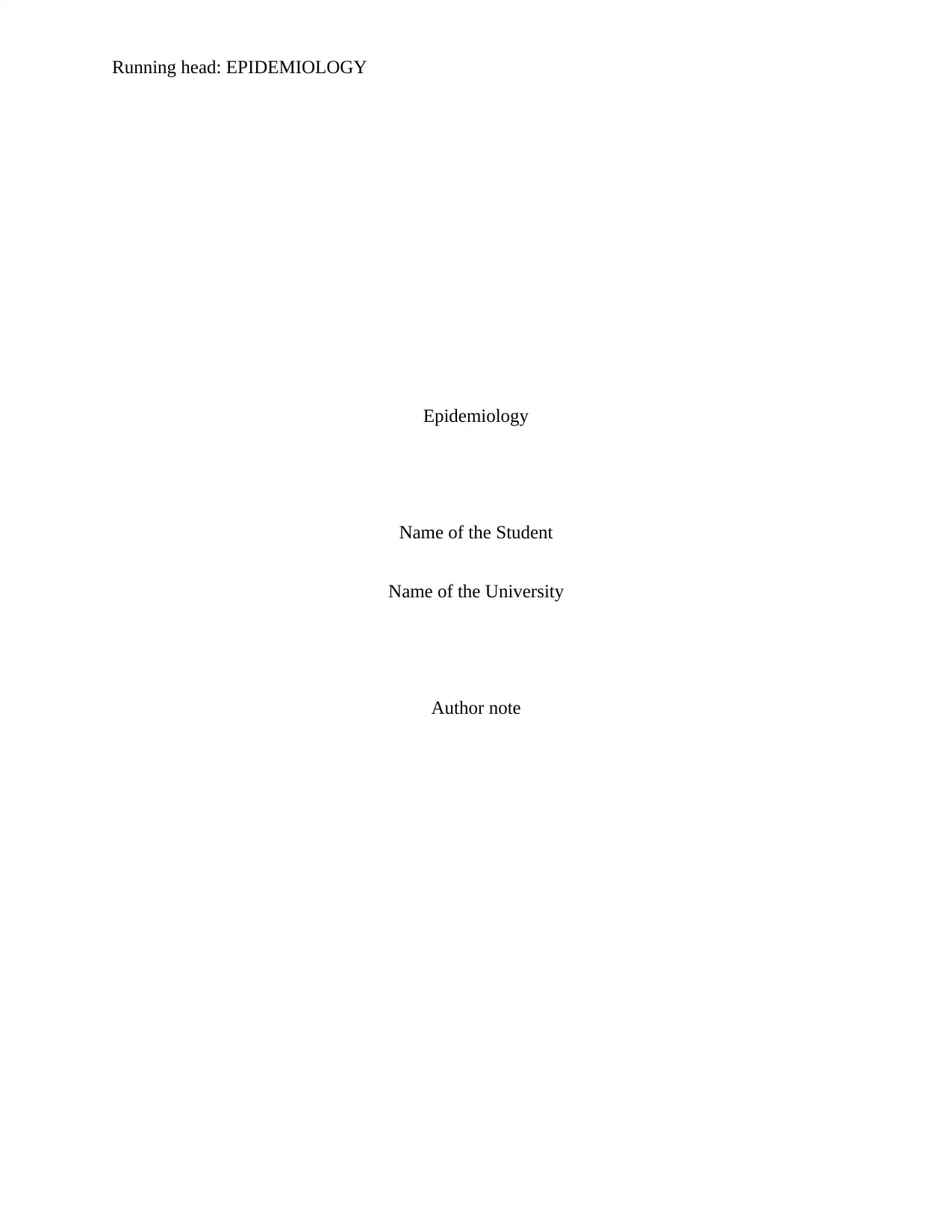
Running head: EPIDEMIOLOGY
Epidemiology
Name of the Student
Name of the University
Author note
Epidemiology
Name of the Student
Name of the University
Author note
Paraphrase This Document
Need a fresh take? Get an instant paraphrase of this document with our AI Paraphraser
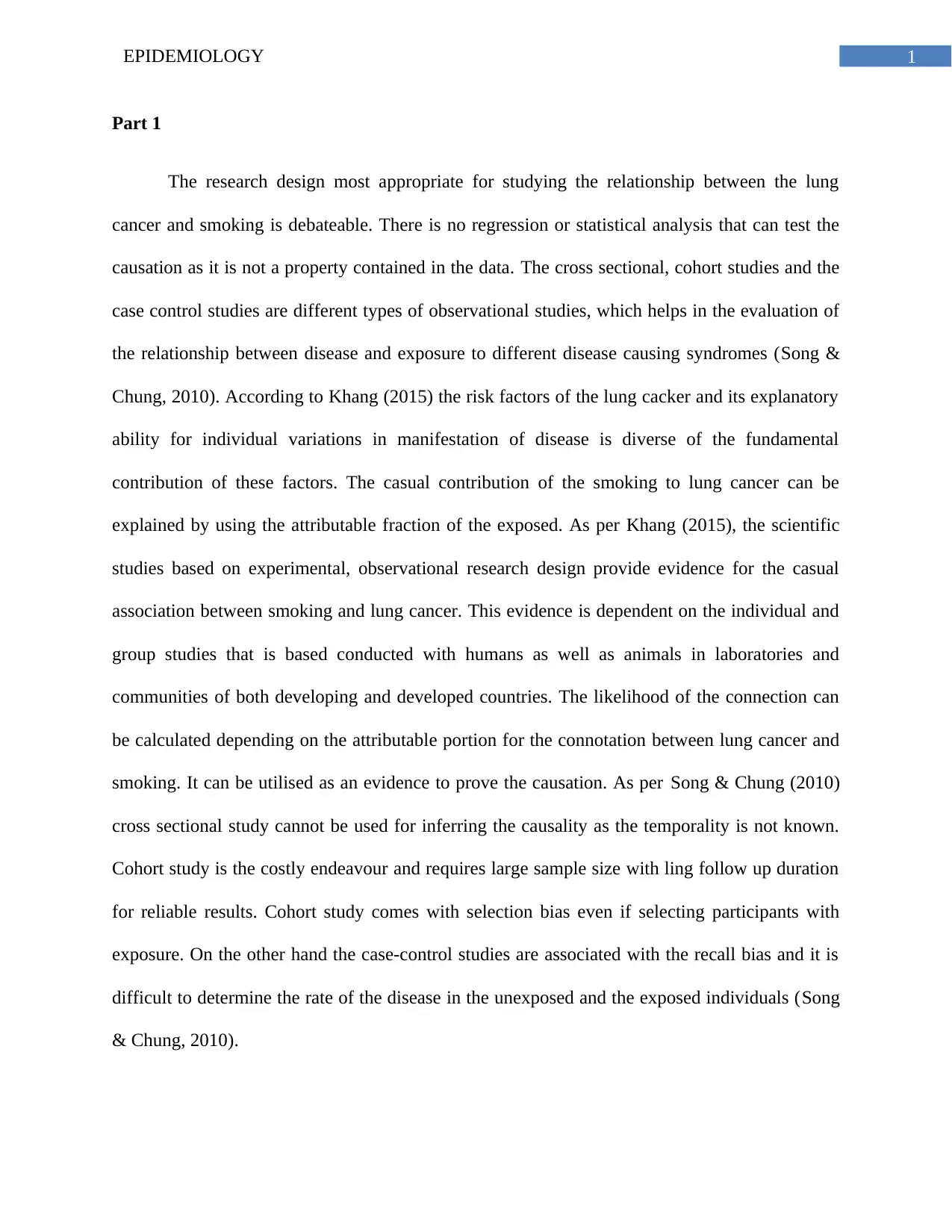
1EPIDEMIOLOGY
Part 1
The research design most appropriate for studying the relationship between the lung
cancer and smoking is debateable. There is no regression or statistical analysis that can test the
causation as it is not a property contained in the data. The cross sectional, cohort studies and the
case control studies are different types of observational studies, which helps in the evaluation of
the relationship between disease and exposure to different disease causing syndromes (Song &
Chung, 2010). According to Khang (2015) the risk factors of the lung cacker and its explanatory
ability for individual variations in manifestation of disease is diverse of the fundamental
contribution of these factors. The casual contribution of the smoking to lung cancer can be
explained by using the attributable fraction of the exposed. As per Khang (2015), the scientific
studies based on experimental, observational research design provide evidence for the casual
association between smoking and lung cancer. This evidence is dependent on the individual and
group studies that is based conducted with humans as well as animals in laboratories and
communities of both developing and developed countries. The likelihood of the connection can
be calculated depending on the attributable portion for the connotation between lung cancer and
smoking. It can be utilised as an evidence to prove the causation. As per Song & Chung (2010)
cross sectional study cannot be used for inferring the causality as the temporality is not known.
Cohort study is the costly endeavour and requires large sample size with ling follow up duration
for reliable results. Cohort study comes with selection bias even if selecting participants with
exposure. On the other hand the case-control studies are associated with the recall bias and it is
difficult to determine the rate of the disease in the unexposed and the exposed individuals (Song
& Chung, 2010).
Part 1
The research design most appropriate for studying the relationship between the lung
cancer and smoking is debateable. There is no regression or statistical analysis that can test the
causation as it is not a property contained in the data. The cross sectional, cohort studies and the
case control studies are different types of observational studies, which helps in the evaluation of
the relationship between disease and exposure to different disease causing syndromes (Song &
Chung, 2010). According to Khang (2015) the risk factors of the lung cacker and its explanatory
ability for individual variations in manifestation of disease is diverse of the fundamental
contribution of these factors. The casual contribution of the smoking to lung cancer can be
explained by using the attributable fraction of the exposed. As per Khang (2015), the scientific
studies based on experimental, observational research design provide evidence for the casual
association between smoking and lung cancer. This evidence is dependent on the individual and
group studies that is based conducted with humans as well as animals in laboratories and
communities of both developing and developed countries. The likelihood of the connection can
be calculated depending on the attributable portion for the connotation between lung cancer and
smoking. It can be utilised as an evidence to prove the causation. As per Song & Chung (2010)
cross sectional study cannot be used for inferring the causality as the temporality is not known.
Cohort study is the costly endeavour and requires large sample size with ling follow up duration
for reliable results. Cohort study comes with selection bias even if selecting participants with
exposure. On the other hand the case-control studies are associated with the recall bias and it is
difficult to determine the rate of the disease in the unexposed and the exposed individuals (Song
& Chung, 2010).
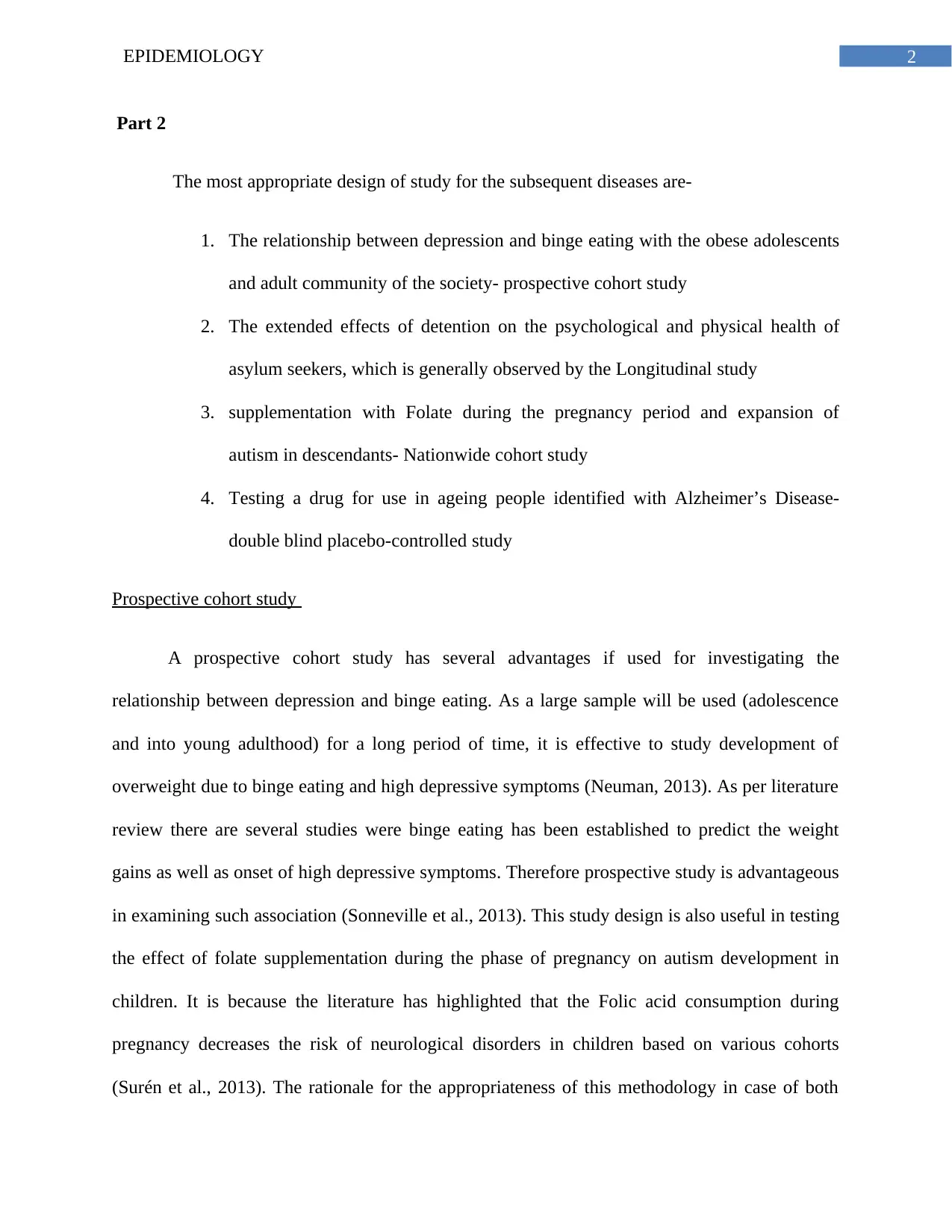
2EPIDEMIOLOGY
Part 2
The most appropriate design of study for the subsequent diseases are-
1. The relationship between depression and binge eating with the obese adolescents
and adult community of the society- prospective cohort study
2. The extended effects of detention on the psychological and physical health of
asylum seekers, which is generally observed by the Longitudinal study
3. supplementation with Folate during the pregnancy period and expansion of
autism in descendants- Nationwide cohort study
4. Testing a drug for use in ageing people identified with Alzheimer’s Disease-
double blind placebo-controlled study
Prospective cohort study
A prospective cohort study has several advantages if used for investigating the
relationship between depression and binge eating. As a large sample will be used (adolescence
and into young adulthood) for a long period of time, it is effective to study development of
overweight due to binge eating and high depressive symptoms (Neuman, 2013). As per literature
review there are several studies were binge eating has been established to predict the weight
gains as well as onset of high depressive symptoms. Therefore prospective study is advantageous
in examining such association (Sonneville et al., 2013). This study design is also useful in testing
the effect of folate supplementation during the phase of pregnancy on autism development in
children. It is because the literature has highlighted that the Folic acid consumption during
pregnancy decreases the risk of neurological disorders in children based on various cohorts
(Surén et al., 2013). The rationale for the appropriateness of this methodology in case of both
Part 2
The most appropriate design of study for the subsequent diseases are-
1. The relationship between depression and binge eating with the obese adolescents
and adult community of the society- prospective cohort study
2. The extended effects of detention on the psychological and physical health of
asylum seekers, which is generally observed by the Longitudinal study
3. supplementation with Folate during the pregnancy period and expansion of
autism in descendants- Nationwide cohort study
4. Testing a drug for use in ageing people identified with Alzheimer’s Disease-
double blind placebo-controlled study
Prospective cohort study
A prospective cohort study has several advantages if used for investigating the
relationship between depression and binge eating. As a large sample will be used (adolescence
and into young adulthood) for a long period of time, it is effective to study development of
overweight due to binge eating and high depressive symptoms (Neuman, 2013). As per literature
review there are several studies were binge eating has been established to predict the weight
gains as well as onset of high depressive symptoms. Therefore prospective study is advantageous
in examining such association (Sonneville et al., 2013). This study design is also useful in testing
the effect of folate supplementation during the phase of pregnancy on autism development in
children. It is because the literature has highlighted that the Folic acid consumption during
pregnancy decreases the risk of neurological disorders in children based on various cohorts
(Surén et al., 2013). The rationale for the appropriateness of this methodology in case of both
⊘ This is a preview!⊘
Do you want full access?
Subscribe today to unlock all pages.

Trusted by 1+ million students worldwide
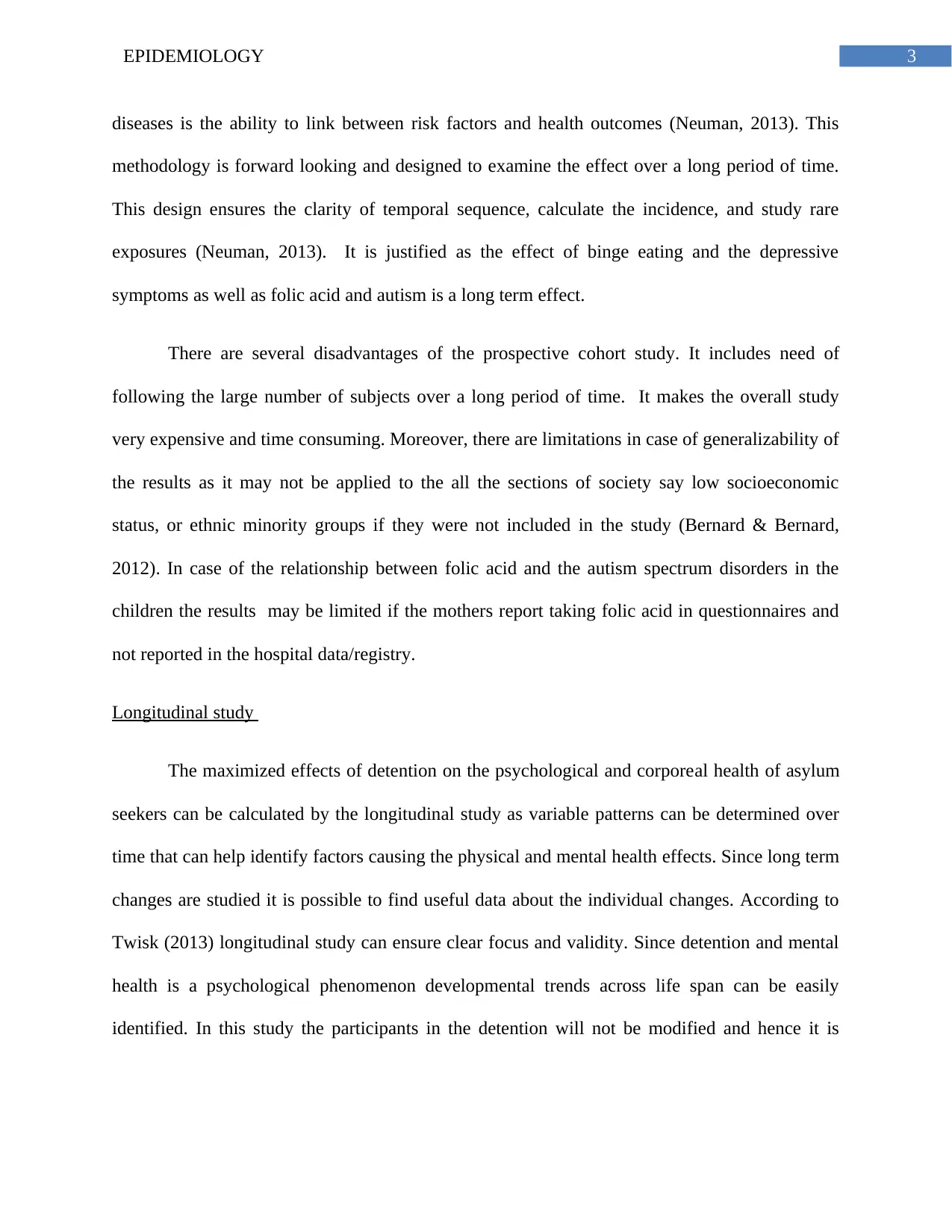
3EPIDEMIOLOGY
diseases is the ability to link between risk factors and health outcomes (Neuman, 2013). This
methodology is forward looking and designed to examine the effect over a long period of time.
This design ensures the clarity of temporal sequence, calculate the incidence, and study rare
exposures (Neuman, 2013). It is justified as the effect of binge eating and the depressive
symptoms as well as folic acid and autism is a long term effect.
There are several disadvantages of the prospective cohort study. It includes need of
following the large number of subjects over a long period of time. It makes the overall study
very expensive and time consuming. Moreover, there are limitations in case of generalizability of
the results as it may not be applied to the all the sections of society say low socioeconomic
status, or ethnic minority groups if they were not included in the study (Bernard & Bernard,
2012). In case of the relationship between folic acid and the autism spectrum disorders in the
children the results may be limited if the mothers report taking folic acid in questionnaires and
not reported in the hospital data/registry.
Longitudinal study
The maximized effects of detention on the psychological and corporeal health of asylum
seekers can be calculated by the longitudinal study as variable patterns can be determined over
time that can help identify factors causing the physical and mental health effects. Since long term
changes are studied it is possible to find useful data about the individual changes. According to
Twisk (2013) longitudinal study can ensure clear focus and validity. Since detention and mental
health is a psychological phenomenon developmental trends across life span can be easily
identified. In this study the participants in the detention will not be modified and hence it is
diseases is the ability to link between risk factors and health outcomes (Neuman, 2013). This
methodology is forward looking and designed to examine the effect over a long period of time.
This design ensures the clarity of temporal sequence, calculate the incidence, and study rare
exposures (Neuman, 2013). It is justified as the effect of binge eating and the depressive
symptoms as well as folic acid and autism is a long term effect.
There are several disadvantages of the prospective cohort study. It includes need of
following the large number of subjects over a long period of time. It makes the overall study
very expensive and time consuming. Moreover, there are limitations in case of generalizability of
the results as it may not be applied to the all the sections of society say low socioeconomic
status, or ethnic minority groups if they were not included in the study (Bernard & Bernard,
2012). In case of the relationship between folic acid and the autism spectrum disorders in the
children the results may be limited if the mothers report taking folic acid in questionnaires and
not reported in the hospital data/registry.
Longitudinal study
The maximized effects of detention on the psychological and corporeal health of asylum
seekers can be calculated by the longitudinal study as variable patterns can be determined over
time that can help identify factors causing the physical and mental health effects. Since long term
changes are studied it is possible to find useful data about the individual changes. According to
Twisk (2013) longitudinal study can ensure clear focus and validity. Since detention and mental
health is a psychological phenomenon developmental trends across life span can be easily
identified. In this study the participants in the detention will not be modified and hence it is
Paraphrase This Document
Need a fresh take? Get an instant paraphrase of this document with our AI Paraphraser
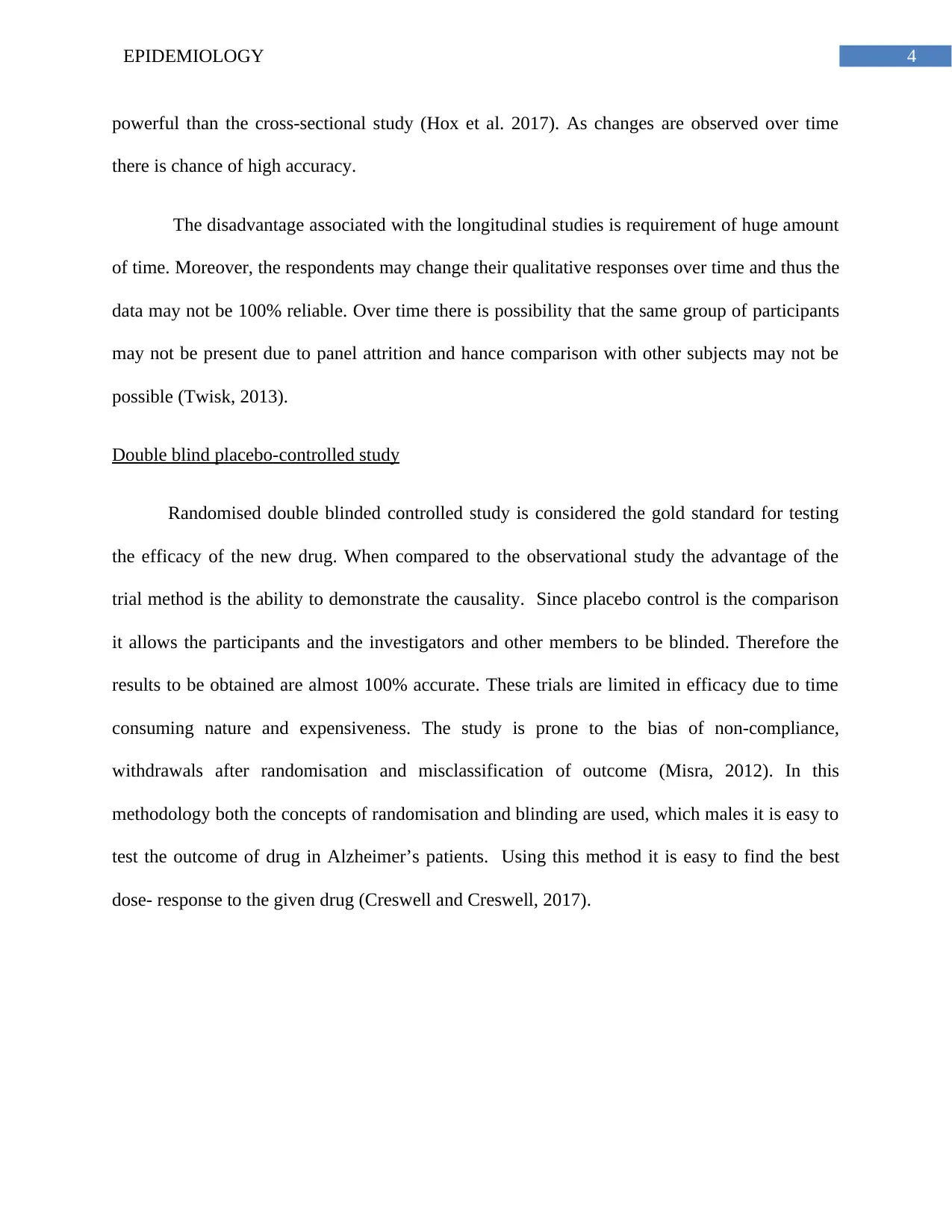
4EPIDEMIOLOGY
powerful than the cross-sectional study (Hox et al. 2017). As changes are observed over time
there is chance of high accuracy.
The disadvantage associated with the longitudinal studies is requirement of huge amount
of time. Moreover, the respondents may change their qualitative responses over time and thus the
data may not be 100% reliable. Over time there is possibility that the same group of participants
may not be present due to panel attrition and hance comparison with other subjects may not be
possible (Twisk, 2013).
Double blind placebo-controlled study
Randomised double blinded controlled study is considered the gold standard for testing
the efficacy of the new drug. When compared to the observational study the advantage of the
trial method is the ability to demonstrate the causality. Since placebo control is the comparison
it allows the participants and the investigators and other members to be blinded. Therefore the
results to be obtained are almost 100% accurate. These trials are limited in efficacy due to time
consuming nature and expensiveness. The study is prone to the bias of non-compliance,
withdrawals after randomisation and misclassification of outcome (Misra, 2012). In this
methodology both the concepts of randomisation and blinding are used, which males it is easy to
test the outcome of drug in Alzheimer’s patients. Using this method it is easy to find the best
dose- response to the given drug (Creswell and Creswell, 2017).
powerful than the cross-sectional study (Hox et al. 2017). As changes are observed over time
there is chance of high accuracy.
The disadvantage associated with the longitudinal studies is requirement of huge amount
of time. Moreover, the respondents may change their qualitative responses over time and thus the
data may not be 100% reliable. Over time there is possibility that the same group of participants
may not be present due to panel attrition and hance comparison with other subjects may not be
possible (Twisk, 2013).
Double blind placebo-controlled study
Randomised double blinded controlled study is considered the gold standard for testing
the efficacy of the new drug. When compared to the observational study the advantage of the
trial method is the ability to demonstrate the causality. Since placebo control is the comparison
it allows the participants and the investigators and other members to be blinded. Therefore the
results to be obtained are almost 100% accurate. These trials are limited in efficacy due to time
consuming nature and expensiveness. The study is prone to the bias of non-compliance,
withdrawals after randomisation and misclassification of outcome (Misra, 2012). In this
methodology both the concepts of randomisation and blinding are used, which males it is easy to
test the outcome of drug in Alzheimer’s patients. Using this method it is easy to find the best
dose- response to the given drug (Creswell and Creswell, 2017).
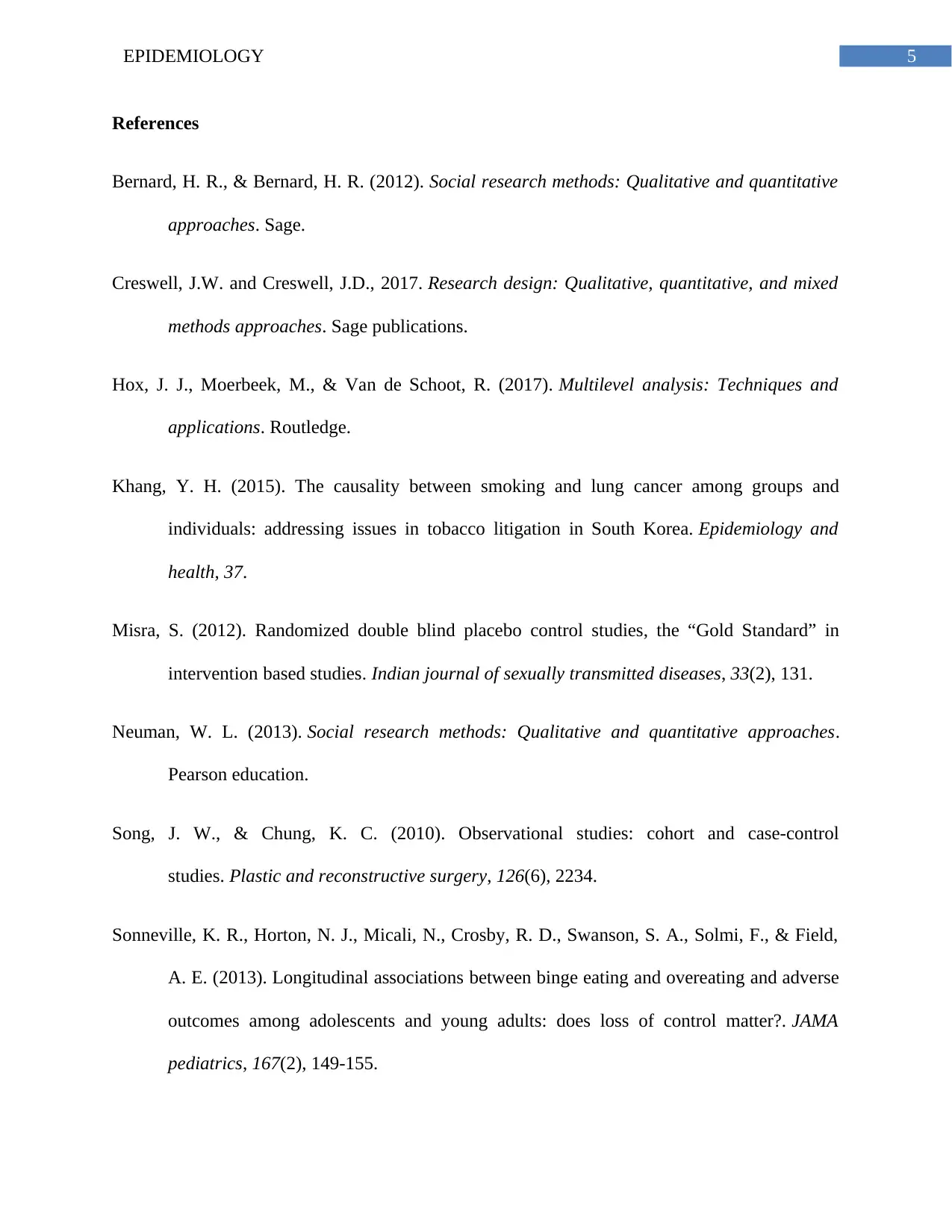
5EPIDEMIOLOGY
References
Bernard, H. R., & Bernard, H. R. (2012). Social research methods: Qualitative and quantitative
approaches. Sage.
Creswell, J.W. and Creswell, J.D., 2017. Research design: Qualitative, quantitative, and mixed
methods approaches. Sage publications.
Hox, J. J., Moerbeek, M., & Van de Schoot, R. (2017). Multilevel analysis: Techniques and
applications. Routledge.
Khang, Y. H. (2015). The causality between smoking and lung cancer among groups and
individuals: addressing issues in tobacco litigation in South Korea. Epidemiology and
health, 37.
Misra, S. (2012). Randomized double blind placebo control studies, the “Gold Standard” in
intervention based studies. Indian journal of sexually transmitted diseases, 33(2), 131.
Neuman, W. L. (2013). Social research methods: Qualitative and quantitative approaches.
Pearson education.
Song, J. W., & Chung, K. C. (2010). Observational studies: cohort and case-control
studies. Plastic and reconstructive surgery, 126(6), 2234.
Sonneville, K. R., Horton, N. J., Micali, N., Crosby, R. D., Swanson, S. A., Solmi, F., & Field,
A. E. (2013). Longitudinal associations between binge eating and overeating and adverse
outcomes among adolescents and young adults: does loss of control matter?. JAMA
pediatrics, 167(2), 149-155.
References
Bernard, H. R., & Bernard, H. R. (2012). Social research methods: Qualitative and quantitative
approaches. Sage.
Creswell, J.W. and Creswell, J.D., 2017. Research design: Qualitative, quantitative, and mixed
methods approaches. Sage publications.
Hox, J. J., Moerbeek, M., & Van de Schoot, R. (2017). Multilevel analysis: Techniques and
applications. Routledge.
Khang, Y. H. (2015). The causality between smoking and lung cancer among groups and
individuals: addressing issues in tobacco litigation in South Korea. Epidemiology and
health, 37.
Misra, S. (2012). Randomized double blind placebo control studies, the “Gold Standard” in
intervention based studies. Indian journal of sexually transmitted diseases, 33(2), 131.
Neuman, W. L. (2013). Social research methods: Qualitative and quantitative approaches.
Pearson education.
Song, J. W., & Chung, K. C. (2010). Observational studies: cohort and case-control
studies. Plastic and reconstructive surgery, 126(6), 2234.
Sonneville, K. R., Horton, N. J., Micali, N., Crosby, R. D., Swanson, S. A., Solmi, F., & Field,
A. E. (2013). Longitudinal associations between binge eating and overeating and adverse
outcomes among adolescents and young adults: does loss of control matter?. JAMA
pediatrics, 167(2), 149-155.
⊘ This is a preview!⊘
Do you want full access?
Subscribe today to unlock all pages.

Trusted by 1+ million students worldwide
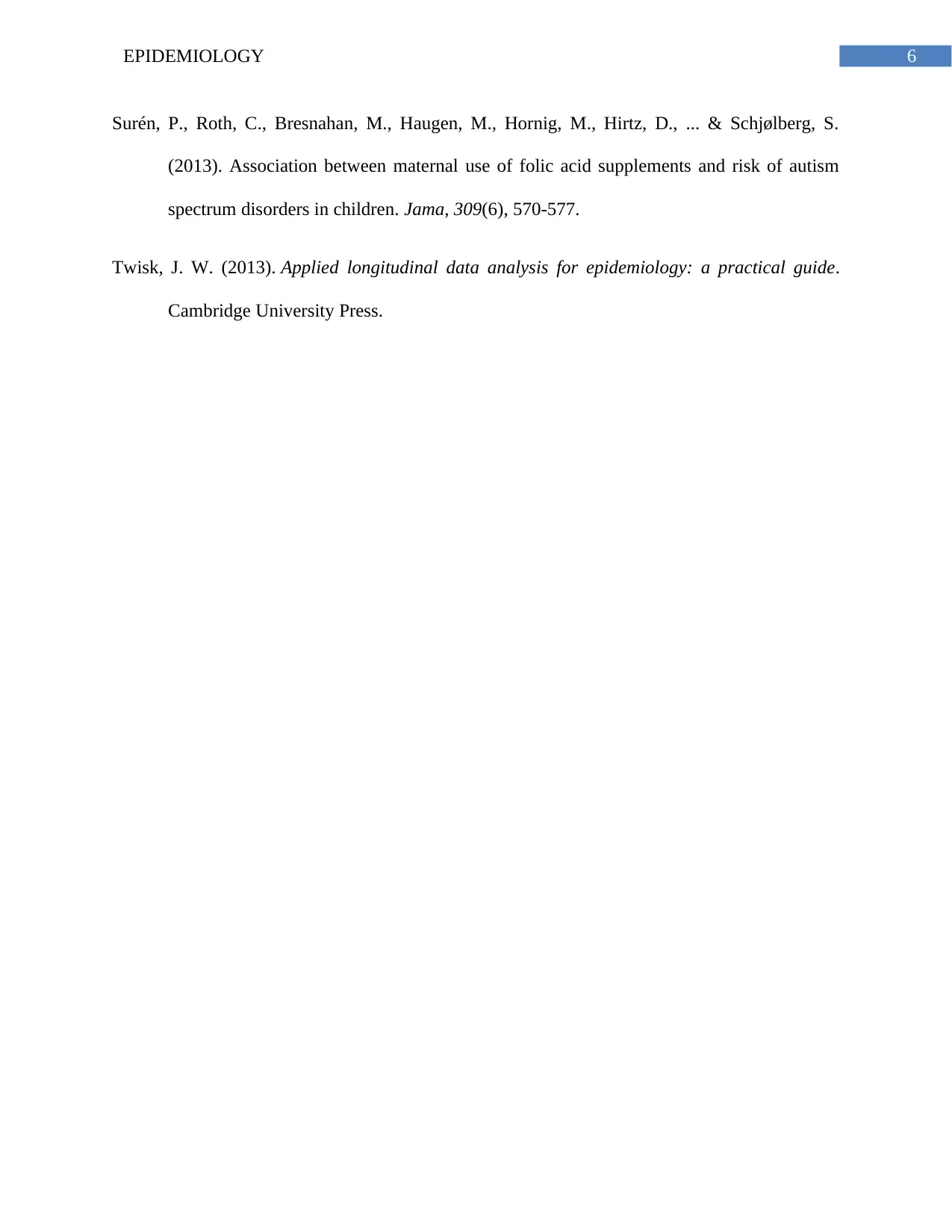
6EPIDEMIOLOGY
Surén, P., Roth, C., Bresnahan, M., Haugen, M., Hornig, M., Hirtz, D., ... & Schjølberg, S.
(2013). Association between maternal use of folic acid supplements and risk of autism
spectrum disorders in children. Jama, 309(6), 570-577.
Twisk, J. W. (2013). Applied longitudinal data analysis for epidemiology: a practical guide.
Cambridge University Press.
Surén, P., Roth, C., Bresnahan, M., Haugen, M., Hornig, M., Hirtz, D., ... & Schjølberg, S.
(2013). Association between maternal use of folic acid supplements and risk of autism
spectrum disorders in children. Jama, 309(6), 570-577.
Twisk, J. W. (2013). Applied longitudinal data analysis for epidemiology: a practical guide.
Cambridge University Press.
1 out of 7
Related Documents
Your All-in-One AI-Powered Toolkit for Academic Success.
+13062052269
info@desklib.com
Available 24*7 on WhatsApp / Email
![[object Object]](/_next/static/media/star-bottom.7253800d.svg)
Unlock your academic potential
Copyright © 2020–2025 A2Z Services. All Rights Reserved. Developed and managed by ZUCOL.



